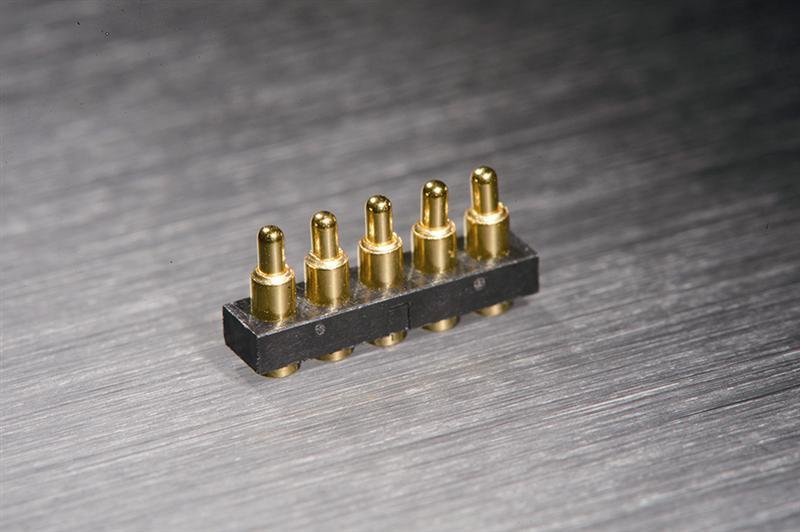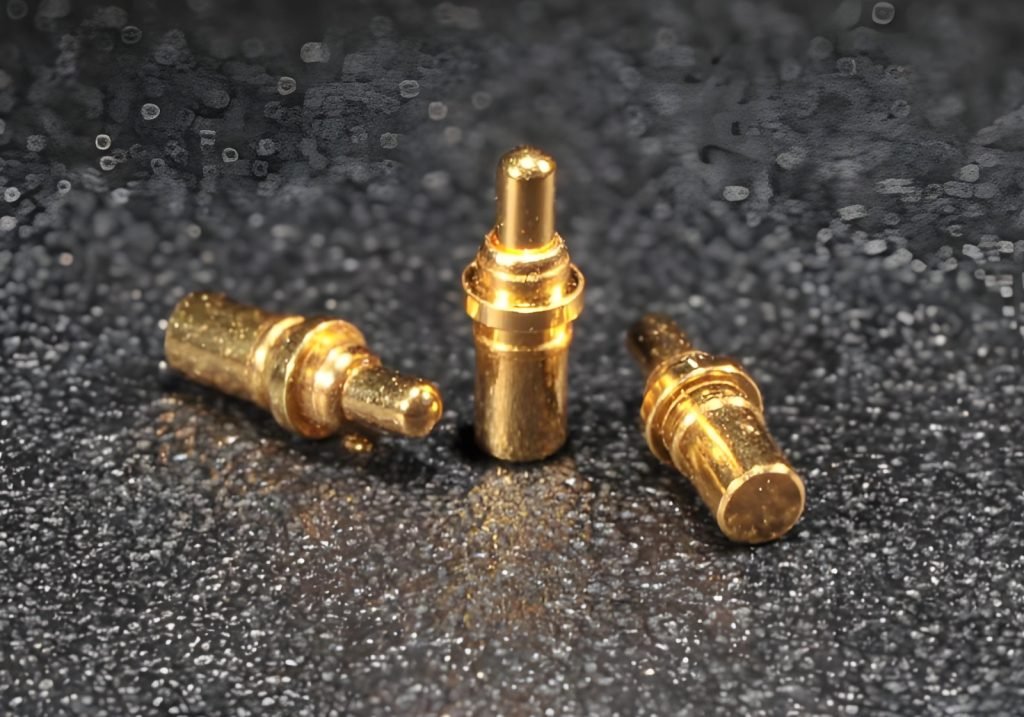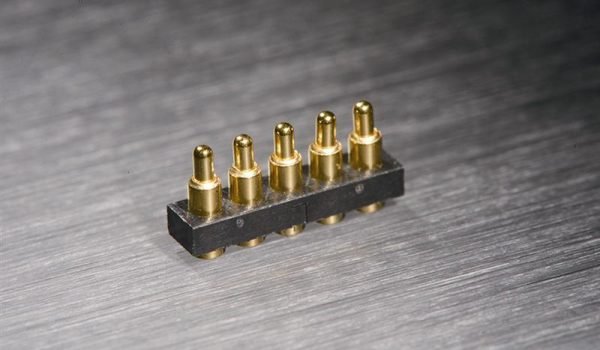Pogo pins are compact yet vital equipment that finds applications across electronics, automotive, and medical disciplines, as well as aerospace and industrial automation systems. The spring prototypes of these electrical components provide dependable high-performance signal connections to devices operating in environments with repeated mating cycles or movement and vibration.
Since pogo pins differ from traditional connector types, they yield low contact resistance, high durability, and superior conductivity. Pogo pins find applications in smartphone connectivity, electric vehicles, robotic functions, medical instruments, and testing Printed Circuit Boards.
This article will cover:
The article explains pogo pins and demonstrates their operational principles.
- Different types of pogo pins and their specific applications
- Pogo pins deliver better performance than conventional connectors because of their advantages.
- The Pogo pins’ production process requires CNC machining and CNC turning techniques.
- Fecision pogo pins deliver exceptional performance because of multiple benefits.

What Are Pogo Pins?
Pogo pins, or spring-loaded connectors, are electrical contacts that use an internal spring structure to create a dependable connection. Devices that must be plugged in and out frequently use them because of their high durability and dependability.
Component of Pogo Pin
A pogo pin has three main parts: The barrel is the container that holds the plunger and spring in place. The spring is a compressed element inside the barrel that guarantees electrical contact. The plunger is the contact point at the top that attaches to the target device.
Pogo pins can:
✔ Absorb mechanical stress and guarantee stable connections thanks to this design.
✔ Withstand movement, shock, and vibration
✔ Offer high conductivity and low resistance
How Do Pogo Pins Work?
The spring-loaded design of pogo pins produces consistent contact pressure between mating surfaces. This is how they work:
1. Establishing Contact: An electrical contact is made when the plunger touches the target surface.
2. Compression of Spring: The internal spring compresses despite mechanical fluctuations to form a strong and stable connection.
3. Stable Electrical Flow: The spring does not disengage even when the device is moving or vibrating.
4. Release & Reusability: When the device is disconnected, the spring returns the plunger to its starting position, allowing it to be used again.
Pogo pins are more reliable in dynamic applications than conventional connectors because of their self-adjusting mechanism.
Types of Pogo Pins and Their Applications
Pogo pins come in various designs, each suitable for commercial and industrial applications. Let’s talk about the most common kinds:
1. Ordinary Pogo Pins
Qualities:
- Regular spring-loaded connector with moderate contact pressure
- Gold-plated to prevent corrosion
Applications:
- PCB testing;
- Docking stations for laptops and smartphones;
- Battery charging connectors.
2. Pogo Pins with High Frequency
Qualities:
- It is employed to send signals at high speeds
- Low resistance to guarantee the least amount of signal loss
- Used in microwave and radio frequency (RF) technology?
Applications:
- 5G network equipment
- High-speed data transfer systems;
- Telecommunications equipment
3. What Are the Latest Pogo Pins
Qualities
- Robust springs and thicker barrels;
- Capable of withstanding currents ranging from 10A to 50A;
- Suitable for high-power applications
Applications
- Connectors for charging electric vehicles (EVs);
- Industrial battery packs;
- And power distribution for automobiles
4. Multi-Point Contact Pogo Pins
Qualities:
- Enhanced conductivity from multiple contact points;
- Decreased misalignment-related connection failures;
- And steady signal flow
Applications
- Medical imaging equipment
- Automotive safety sensors and
- aerospace engineering
5. Rotational Pogo Pins
Qualities
- Use in devices that need to rotate continuously;
- They can tolerate rotational movement;
- They prevent wear and tear from friction;
Applications
- Rotating industrial sensors
- Fitness trackers
- Smartwatches
- Automotive steering sensors.
6. Long-Stroke Pogo Pins
Qualities
- Extended spring length for added flexibility;
- Able to withstand high mechanical stress and vibration;
- Perfect for shock-resistant environments
Application:
- Heavy-duty industrial machines;
- Robotics and automation;
- Military-grade equipment;
7. Threaded Pogo Pins:
Qualities
- Suitable for long-term electrical connections
- Designed to ensure maximum stability
Applications
- Suitable for medical devices
- Aerospace systems
- Automated production lines

Pogo Pins’ Benefits Compared to Conventional Connectors
In comparison to conventional connectors, pogo pins offer the following advantages:
✅ Durability – Supports millions of mating cycles
✅ Low Contact Resistance – Enhances signal transmission and power efficiency
✅ Compact Design – Fits well with miniaturized electronics
✅ Resistance to Environmental Factors – Functions well in high temperatures, humidity, and vibration
✅ Fast and Secure Connections – Perfect for high-speed manufacturing
Pogo pins are the go-to option for many industries because of these characteristics.
How Pogo Pin Manufacturing Is Improved by CNC Machining and CNC Turning
- CNC machining and turning are used to achieve the high precision needed for pogo pin manufacturing.
- CNC machining guarantees tight tolerances and high repeatability, while CNC turning produces smooth finishes and uniform dimensions.
- Ensures superior electrical performance and premium pogo pins
At Fecision, we use state-of-the-art CNC machining to manufacture pogo pins that meet the highest industry standards.
Choosing the Right Pogo Pin for Your Application
When selecting a pogo pin, consider these factors:
- Select high-current pogo pins
- for harsh industrial environments
- use rugged pogo pins for spring force and travel distance
- use long-stroke pogo pins for increased flexibility and plating material,
- use gold-plated pogo pins for superior conductivity.
- Choosing the appropriate pogo pin can guarantee optimum performance and long-term dependability.
Why Pick Pogo Pins from Fecision?
Our specialty at Fengchi is creating unique pogo pin solutions for various business requirements.
- Modern CNC-machined pogo pins for optimal accuracy
- Dependable, superior electrical performance
- Adaptable designs for specific uses
Fecision offers premium solutions for standard pogo pins, high-frequency connectors, and custom configurations.
To discuss your pogo pin needs, contact Fengchi right now!
The Importance of Spring-Loaded Connectors (Pogo Pins) in Modern Electronics
Pogo pins, or spring-loaded connectors, are essential for electronic devices because they allow for dependable, effective, and long-lasting electrical connections. Their unique design, consisting of a spring-loaded plunger inside a precisely machined barrel, offers flexible operation, high durability, and reliable contact in various applications.
Why Are Spring-Loaded Connectors Important?
1. Reliable & Consistent Electrical Contact
Spring-loaded connectors guarantee a steady, low-resistance electrical connection even in high-vibration situations. Pogo pins are perfect for wearable technology, medical equipment, and battery chargers because they maintain constant pressure, unlike standard connectors that may loosen over time.
2. Extended Lifespan & High Durability
Long-term dependability in consumer and industrial electronics is ensured by spring-loaded connectors, which can endure over 100,000 mating cycles and have a self-cleaning mechanism that lowers corrosion and dust accumulation.
3. Compact & Space-Saving Design
Lightweight and tiny, spring-loaded connectors enable the creation of electronic devices that are more streamlined and effective. Their design facilitates miniaturization in IoT devices, hearing aids, and smartphones, among other applications.
4. Misalignment Tolerance
Spring-loaded connectors compensate for minor positioning errors, which makes them ideal for robotics, docking stations, and automated test equipment (ATE) where alignment variations may occur. This is in contrast to traditional connectors, which need precise alignment.
5. Versatile Applications Across Industries
Consumer electronics, including smartwatches, earbuds, and wireless charging docks, frequently use spring-loaded connectors.
- Medical devices: diagnostic tools and wearable health monitors.
- Automotive Sector: infotainment systems and battery connectors.
- Industrial and Robotics: automated equipment, PCB test probes, and test jigs.

Conclusion
Pogo pins provide excellent performance, low resistance, and high durability and are crucial connectors in contemporary electronics. Choosing the appropriate pogo pin improves the longevity and efficiency of devices in various applications, including consumer electronics, medical devices, automotive, and aerospace.
At Fecision, we produce premium pogo pins that are CNC-machined to the highest industry standards. Contact Fengchi to learn more about our custom pogo pin manufacturing options.
FAQs
1. Why is it better to use pogo pins rather than traditional connectors?
Pogo pins are also more durable, have better vibration and movement performance, frequent mating cycles, and lower contact resistance. They also offer compact designs, making them suitable for miniaturized electronic devices.
2. What is the maximum amount of mating cycles pogo pins can withstand?
Depending on the spring design, plating material, and conditions of use, high-quality pogo pins can be expected to have more than 1 million mating cycles without significant degradation.
3. What kinds of materials are frequently used to make pogo pins?
Pogo pins made of brass or copper alloy are typically plated in gold or nickel on the outside to improve their durability, electrical conductivity, and corrosion resistance.
4. Is a pogo pin appropriate?
Examine environmental conditions, plating material, spring force, stroke length, and current capacity. We use high-current pogo pins for high-power applications and high-frequency pogo pins for data transfer or radio-frequency applications.




